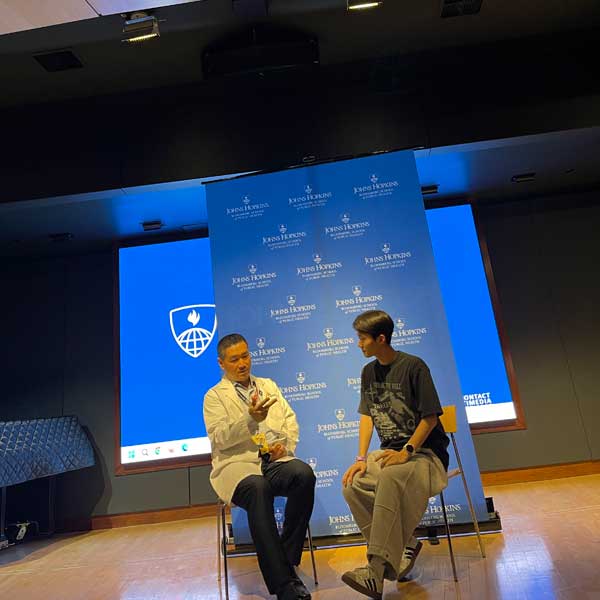The Future of Dementia and Parkinson’s Treatment: How AI, Omics, and Bioengineering are Shaping the Next Generation of Neurodegenerative Disease Treatment

[Dr. Sung-Ung Kang (left) being interviewed by Kim Dong-Geon (right) at the Johns Hopkins University, School of Medicine. Photo Credit: Donggeon Kim]
In the fight against degenerative brain diseases such as dementia and Parkinson’s disease, advances in artificial intelligence, omics technologies, and bioengineering are opening a channel for a new era of personalized, more effective treatments.
At the forefront of regenerative neuroscience and molecular therapeutics, the Institute for Cell Engineering (ICE) at Johns Hopkins Medicine is dedicated to advancing our understanding of how cells can be engineered to restore function in neurological diseases.
The institute brings together experts in various fields across neurology, stem cell biology, and computational medicine to tackle some of the most pressing challenges in brain science.
Among its core faculty is a team pushing the boundaries of how neurodegenerative diseases are investigated at the cellular and molecular level.
One such effort is reflected in the most recent study posted on bioRxiv, entitled “Dissecting the molecular landscape of Parkinson’s disease and Parkinson’s disease dementia using highly efficient snRNA-seq (HIF-snRNA-seq)” (2025), which presents a refined method for capturing transcriptomic dynamics in individual brain cells with unprecedented resolution.
To explore how such technologies are shaping the future of dementia and Parkinson’s disease and with dementia treatment, we spoke with Dr. Sung Ung Kang, a faculty member at the Institute and Assistant Professor of Neurology at Johns Hopkins.
His laboratory specializes in integrating AI-driven analytics with multi-omics platforms to identify early biomarkers and therapeutic targets for neurodegenerative disorders.
When asked about the central mission of his research at Johns Hopkins, Dr. Kang stated, “My core goal is to enhance the sensitivity and precision of how we interpret biological data. By doing so, we can detect extremely subtle molecular and cellular changes, sometimes even before symptoms arise.”
Dr. Kang underscored the importance of early detection, noting that it gives us a critical advantage in understanding disease onset and progression.
His lab, in particular, has been developing strategies to identify molecular biomarkers that reflect how neurodegenerative diseases evolve over time.
Dr. Kang’s team integrates proteomics, genomics, and computational methods into their research.
Emphasizing the importance of this multi-omics approach, he explained “Brain diseases like Parkinson’s and dementia are driven by a cascade of changes that unfold at multiple biological layers. No single technology is sufficient to explain this complexity. By combining proteomics (to study proteins), genomics (to study DNA and RNA), and bioinformatics (to interpret large-scale data), we gain a systems-level view.”
Although the application of AI in scientific research remains in its early stages, Dr. Kang utilizes both AI as well as Machine Learning (ML) in his lab.
He stated, “We use AI and ML models to scan and interpret terabytes of single-cell and multiomics data. These tools help us model how individual cells differentiate and interact over time under disease conditions.”
“One key method is trajectory modeling, which tracks how a cell changes from early molecular disturbances to terminal dysfunction across disease progression. This modeling is essential to predict which cell types are most vulnerable and when intervention might be most effective.” Dr. Kang continued.
Given the magnitude of these datasets, Dr. Kang and his team validate them through multiple biological systems. This includes using genetically engineered mice, human iPSC-derived brain organoids, and advanced imaging tools like light-sheet microscopy.
Addressing brain aging, Dr. Kang mentioned, “At its most fundamental level, brain aging can be viewed as a gradual reduction in cellular function, each cell begins to lose its specialized identity. Dementia is, in many ways, an accelerated and pathological version of that process.”
He further discussed the ethical considerations, stating, “With single-cell genomics, we can dissect exactly how and when specific cell populations begin to fail. This also raises philosophical and clinical questions: Do we need to reverse aging, or simply delay its pathological aspects? I believe the answer may vary depending on the disease context.”
Regarding Parkinson’s disease, a neurodegenerative disease affecting the nervous system, Dr. Kang’s research revolves around an interest in the gut-brain axis.
His team is investigating the hypothesis that Parkinson’s disease may originate in the gastrointestinal tract, specifically through the accumulation of misfolded alpha-synuclein proteins in the enteric nervous system, which may then travel via the vagus nerve to the brain.
If this hypothesis holds true, then preventative strategies that begin outside the central nervous system, possibly in the gut microbiome, could come to fruition.
As our interview concluded, Dr. Kang shared his thoughts on the most promising potential developments with the field of biotechnology and neuroscience.
He predicted a shift from reactive to proactive neuroscience, stating, “I believe the greatest breakthroughs will come from merging physical biomarkers such as brain-derived exosomes or blood-based proteins with AI-based analysis platforms.”
Should this breakthrough occur, the fusion will allow us to detect disease earlier, tailor therapies more precisely, and monitor treatment effects in real time.
Dr. Kang also offered advice for aspiring neuroscientists or bioengineers, which was to remain observant of everything happening around them.
Dr. Kang closed with, “Be observant and record what you see. Many transformative discoveries start with something that seems trivial at first. And remember, no major discovery happens in isolation—collaboration and curiosity are your strongest tools.”
As neurodegenerative diseases emerge as a pressing global health challenge, the work of scientists such as Dr. Kang represents the innovators incorporating modern technology into medicine.
By uniting data science, molecular biology, and engineering, his lab is building the foundation for earlier diagnoses, smarter therapeutics, and perhaps even the prevention and treatment of brain disorders.
Looking toward the future of neuroscience, we find it interdisciplinary, data-driven, and, thanks to researchers such as Dr. Kang, an increasingly hopeful field of science.

- Donggeon Kim / Grade 11
- Global Vision Christian School

![THE HERALD STUDENT REPORTERS [US]](/assets/images/logo_student_us.png)
![THE HERALD STUDENT REPORTERS [Canada]](/assets/images/logo_student_ca.png)
